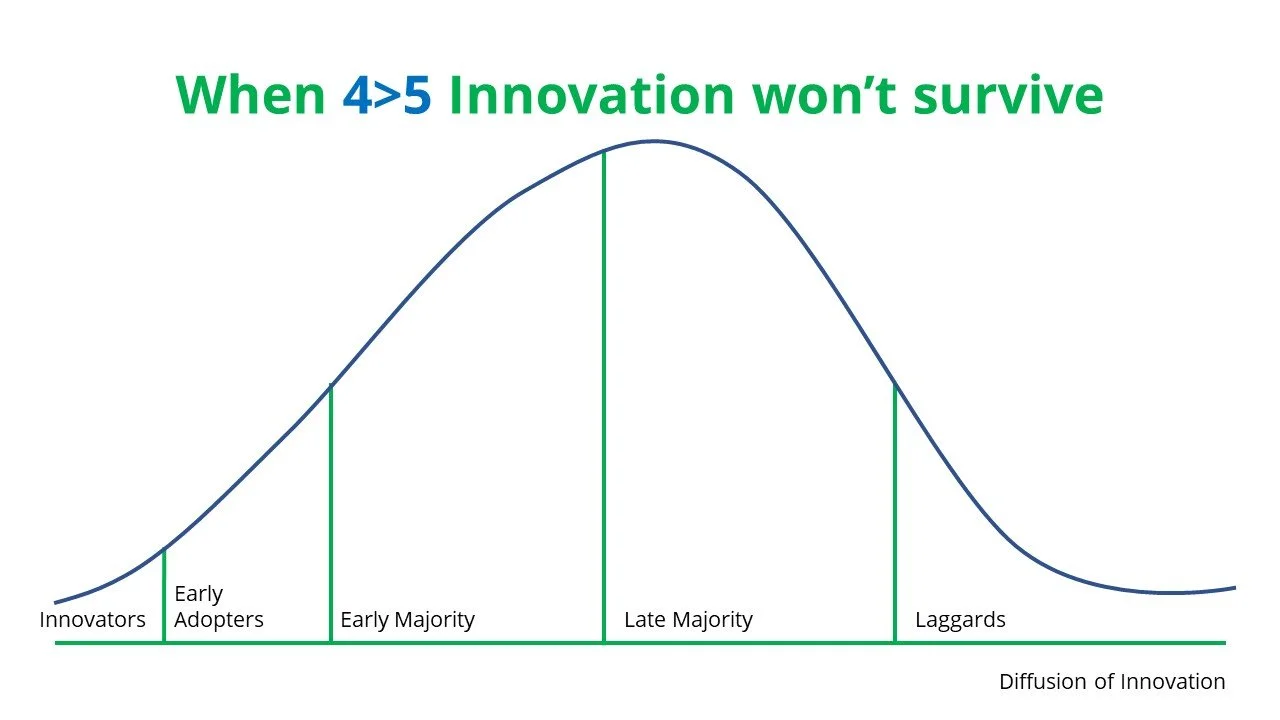Using math to prove that innovation is challenging.
Getting innovation accepted and implemented is challenging for reasons numerous enough to fill an Amazon cart so I want to do us on just three concepts and how they intersect when innovation is brought to the table. What you may notice is how all of them are working to impede acceptance of the innovation.
Innovation for this purpose is defined as any new idea, process, approach, product, or strategy that would require your business, team (family), or customers to do something different.
Concept #1 How many people does it take to make a decision?
I read recently that in the average company, it now takes at least 5 people to agree on a decision before it moves forward.
That means collaboration now equates to consensus in a lot of companies. You aren’t just talking about an idea to get feedback or other viewpoints to validate thinking or look for gaps; you must be actively trying to influence others towards a single shared viewpoint. A viewpoint the group is willing to rally around and champion.
Concept #2 How many people do you need to talk to to find someone who sees the future vision, viability, and value of an innovation?
The Diffusion of Innovation curve says that 2.5 percent of the population are innovators. Innovators are the people who see the potential in an idea or product way before it matures and are willing to take a chance on something that might fail.
If your organization has 100 people, you likely have 2-3 innovators. So to find the 2-3, you would need to talk to a lot of people in your organization, I mean, like all of them, to find people willing to accept your innovation.
That takes a lot of your time and effort to find people who might accept your idea. And you likely need a pretty solid story in place if you want to influence themy to be an innovator.
Concept #3 What does an organization value more than growth and the future?
Humans are designed for survival. Humans create companies. Since companies are constructed and run by humans, companies act like and value the same things humans do.
This means companies make many decisions based on what they think will help them survive today. Survival and growth are not always in alignment. And often, when something is new, it is viewed as an enemy to survival. First, because it creates initial discomfort, and second because its value in helping people survive is uncertain.
For your sanity and survival, you need to embrace that the organization you work for values surviving more than it values anything else. And innovation at its core requires taking a chance on an untested idea. An idea that likely changes the organization's direction. Your idea implies that the current way of life is at risk, and to survive in the future, you must do new something new that you can’t guarantee will work. You are messing with people's happiness, so don’t take it personally when people push back; they are just trying to survive, and they don’t fully understand how your new idea or product is helping in their pursuit of survival.
But wait, there’s more (resistance).
Those are just three factors involved in bringing others along the journey of accepting innovation. We haven’t taken into account all the biases that exist, like confirmation bias or the hurdles like groupthink that makes it hard to influence groups to adopt new ideas. What about the concept of cognitive dissonance or how habits have control over people's attitudes and actions? These will also need to be overcome to get people to adopt your innovation.
Let’s use math to put all of this into perspective. (it’s more algebra than arithmetic)
The Problem: You work in an average organization of 100 people. What is the likelihood of you getting an innovation approved with little or no resistance?
What you need to solve for: Since the research says you will need 5 people to agree on your idea to move it forward, we need to find those five.
Showing your Work: Your organization is 100 people, so the research says only 2-3 will be innovators. So even if you assume you can talk to everyone in your organization, and you find those 2-3 other people that see the value in your innovation. You would still be only at 3-4 people of the 5 needed to move forward. So since 4<5 the answer is...
Your conclusion: There is no chance of moving the innovation forward. Everything is hopeless. Run for the hills and find a cave or lock yourself in your bunker or do whatever you plan to do when the apocalypse arrives. Your tribe has rejected your idea; your chances for survival in your company are bleak. Time to go into survival mode.
Don’t be silly; innovation happens in lots of companies, so there must be things you can do to change the math and turn your innovation into a reality.
We will explore what you can do to successfully bring innovation to life more often in part 2 of this article.

